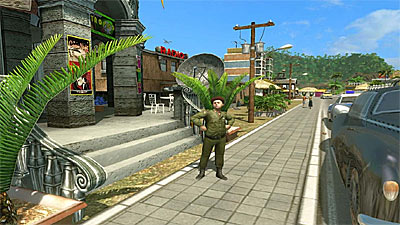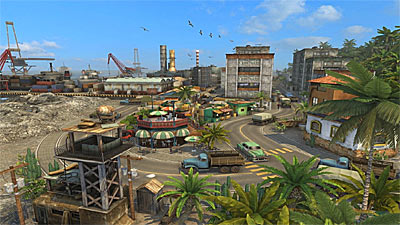City-Building with Caribbean Twist
City building games have been a staple of PC gaming since the beginning. It is a subset of the RTS genre that helped to pioneer both sandbox gameplay and the concept of nearly limitless replayability. Fastforward to the present and the genre remains very much alive and well in Tropico 3; a game that takes the foundation of the genre, adds a great deal of social and economic depth, and finally puts a Latin twist on it for good measure.

Developed by the relatively unknown Haemimont Games and published by the equally unknown Kalypso Media, Tropico 3 has all the features of a city-building game developed by the mainstream likes of Electronic Arts.
The first thing that will grab your attention is the visual quality. Tropico 3 brings the beauty of tropical islands to life very similar to the way Far Cry did. From lush forests to arid deserts, the varying environments on a single island help to break up any visual monotony that would normally be a problem. Of course, this isn’t to say that the random map generator can’t and doesn’t create maps with little variation. Thankfully, the game does allow you to preview the landscape before starting on a new island.
If the visuals aren’t impressive enough, the soundtrack will get certainly get your attention. The music attempts to capture the authentic Caribbean style and does a fairly good job of it. In fact, the only real downside to the soundtrack is that there doesn’t seem to be enough tracks. You will hear the same tracks many, many times during one game, which can last for hours depending on whether you’re playing in sandbox mode or a campaign.
In order to maintain the game’s authenticity, the majority of the voice acting is Spanish. Moreover, any immigrants or workers hired from other countries will mostly speak English. Only the voice acting that the player needs to understand is done in English with a decent Latin American accent. For example, there is a radio announcer that provides regular updates on the situation of the island.

The gameplay isn’t the standard city building players have come to expect from games like Sim City. Instead, Tropico 3’s focus is on the social, political, and economic development of the island nation. The game introduces a few factions that the people align themselves with such as Capitalists, Communists, Nationalists, Militarists, Environmentalists, Intellectuals, and the Religious. And, the player is tasked with appeasing these factions whether by building structures such as churches or military bases, signing edicts that reduce pollution or ban contraceptives, or signing treaties with either the U.S. or the U.S.S.R.
The faction system brings a lot of depth to Tropico 3, and it isn’t just about increasing the happiness of the overall population. Every couple years an election is held on the island that the player must win. Appeasing a majority of the factions helps secure votes, but it’s based on more than making all the factions happy. For example, a majority of the population may belong to a single faction, thus making that faction the most important focus. Knowing which factions to appease and when is crucial to getting reelected. The player can choose to give political speeches during each election, and even pick what topics to address, which can have an effect on the voters.
The elections aren’t the only thing to worry about it. There is also the potential for members of a faction to become rebels. If the player makes a faction angry enough, it will increase the number of rebels. Then, those rebels will attempt to sabotage infrastructure, take hostages, spread propaganda, and even assassinate El Presidente. Of course, being in good standing with the Militarists (the army) allows the player to fend off against rebel attacks, which even play out on the streets when they occur.

Economically, Tropico 3 is based entirely around three major sources of revenue: industry, agriculture, and tourism. The player can use farms, which can be set to harvest a variety of crops from food to tobacco; industrial buildings, which take those crops and produce products; and/or tourism attractions, which bring people to the island who will spend money.
Based on the map the player is given, some economic resources such as oil wells and mining deposits, may not be available, forcing the player to rely on other ways of growing the economy. Economic progression in Tropico 3 is a slow process, even using the 3x speed feature that’s available. Moreover, it needs to be closely watched by the player because of random events that may occur. For example, throughout the game, the state of the world economy may fluctuate, causing an increase or decrease in the price of your exported goods. These events will impact the player’s economy dramatically, forcing the player to take action.
Tropico 3 doesn’t offer a huge number of building variations or options like many city building games do, but it doesn’t need to. The depth of the game doesn’t stem from the cosmetic look of the buildings, but from the dizzying level of depth and customization. For example, all the farms look exactly the same, but the player can set each farm on the island to grow a different crop. Better yet, where the farm is placed affects what types of crops it can grow. Some crops grow best at high altitudes, in high humidity, or in sunny areas. Picking the right crop for the right location can make or break your economy.

To add to the depth, the player can also set the wages of the workers based on the job or education level. Even better than that, players can set wages based on each individual building. For instance, the cooks at one restaurant could make $15 while the cooks at the restaurant close to the tourist’s hotel could make $20. Players are also able to easily set the wages of all the cooks, regardless of which restaurant they work at, as simply as clicking a button. The same thing goes for the education level options, which allow the player to set the wage of all employees with no education, a high school education, or a college education.
Player will have to deal with a variety of problems such as pollution, economic disparity, crime, housing, political unrest, foreign influence, overcrowding, extreme weather, and a variety of random events that can impact the island. Hurricanes can sweep in and destroy key buildings such as electric substations, which could create rolling blackouts across the island, reducing the output of industry buildings that require power and lowering the overall happiness of the population.
Despite the game’s astounding level of depth and options, however, there are a few problems that can cause headaches. For starters, the in-game tutorial is a less-than-adequate introduction to the game mechanics. It does a fine job of getting the player used to the UI and where certain information is represented, but it doesn’t explain how to actually grow the economy or reduce the threat of rebellion. For example, the tutorial will tell the player how to build a farm and set a crop, but it doesn’t make it clear how exactly it contributes to increasing revenue.
There are also some minor control issues. For example, when selecting a building to place on the map, the player uses the middle scroll wheel to rotate the buildings orientation. However, the scroll wheel is also used to zoom in and out, which means the player needs to zoom in close enough prior to selecting a building to ensure the placement is correct.
Placing buildings can also be frustrating, especially around corners of unusable terrain. Couple that with roads that don’t seem to always path correctly the first time, and the player will find that the demolish tool can be their best friend.
Also, while the ability to customize and control an avatar of El Presidente is fun at first, it becomes almost unnecessary at later stages of the game. Luckily, the avatar automatically performs task anyway, which allows the player to focus on other things without it being a distraction.

Overall, Tropico 3 should be applauded for its depth and customization. The game’s visuals along with its unique and authentic soundtrack help draw the player into its Caribbean setting. And, regardless of its few problems, none of which are game-breaking, it does an excellent job of focusing on the political, social, and economic pieces of the game, each of which often affects the others in some way.
Gamers should find that Tropico 3 is one of the better city-building RTS games to come out in a while, and although it may not be much different from its predecessors and its online “features” don’t amount to more than social media “lite,” what it does offer is simply solid and polished gameplay. Newcomers to the series will love the depth of Tropico 3, while veterans may be disappointed with the lack of new features, meanwhile appreciating the visual upgrade.
RATING OUT OF 5 RATING DESCRIPTION 4.0 Graphics
High-quality visuals bring the tropical islands to life, despite some stiff animations. 3.5 Control
Standard city-building RTS controls and UI are easy to learn, despite a few problems with buttons and keys having multiple functions. 4.5 Music / Sound FX / Voice Acting
Amazing, but short, Latin soundtrack, decent sound effects, and mostly adequate voice acting, in both English and Spanish, are only brought down by a slightly annoying and repetitive play-by-play radio commentator, who can be switched off. 4.0 Play Value
Great city-building mechanics with a well-done focus on political, social, and economic gameplay provides a dizzying amount of depth. The online features are underwhelming despite the potential. 4.2 Overall Rating – Great
Not an average. See Rating legend above for a final score breakdown.
Game Features:
